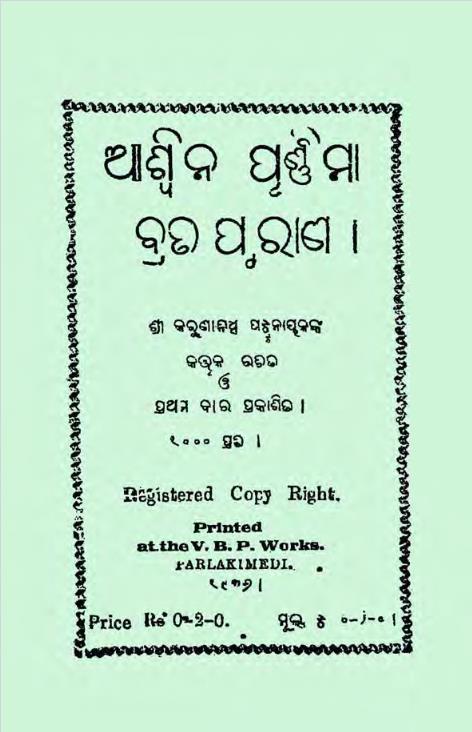In the realm of Odia literature, few works stand out as prominently as “Aswin Purnima Brat Puran,” authored by the esteemed Karunanidhi Patnaik and published in 1936. This remarkable text delves into the rich traditions and rituals associated with the festival of Aswin Purnima, a significant day celebrated during the full moon of the month of Ashwin in the Odia calendar. The work serves as both a spiritual guide and a cultural document, enriching our understanding of the beliefs and practices of the Odia community.
Aswin Purnima, renowned for its spiritual significance, marks the end of the harvest season and is a time for honoring the ancestors. The festival is deeply rooted in tradition, focusing on rituals that pay homage to departed souls, enticing a blend of reverence and celebration. Patnaik’s “Brat Puran” encapsulates the essence of these customs, elucidating the various rites, their meanings, and their potential for spiritual enlightenment.
The text is structured in a way that combines storytelling with instructional elements, guiding devotees through the rituals associated with the observance. Each chapter is interwoven with myths, legends, and anecdotes that provide context to the rituals, making the spiritual experience more relatable and enriching for readers. By doing so, Patnaik bridges the gap between the sacred and the everyday, allowing the modern reader to connect with ancient traditions.
Patnaik’s work is not merely a religious text; it carries immense cultural weight. The author emphasizes the role of family and community in the observance of rituals, portraying Aswin Purnima as a time for gathering and unity. The narrative encourages individuals to partake in communal meals, engage in collective prayers, and share stories, reinforcing the bonds that tie communities together.
Patnaik’s lyrical prose captures the essence of Odia culture, celebrating its rich heritage while also highlighting the importance of preserving traditions in a rapidly changing world. His evocative descriptions allow readers to visualize the vibrant rituals—the offerings of rice, the fragrant flowers, and the flickering lamps that illuminate the night sky during the Purnima celebrations.
At its core, Aswin Purnima Brat Puran serves as a spiritual guide for devotees. Patnaik meticulously explains the significance of each ritual, detailing their potential benefits for both the physical and spiritual well-being of practitioners. He reflects on the transformative power of rituals, urging individuals to approach them with sincerity and devotion.
The text also delves into personal reflections, urging readers to cultivate virtues such as gratitude, compassion, and humility—qualities essential for a fulfilling life. By intertwining practical guidance with philosophical reflections, Patnaik provides a holistic approach to spirituality that resonates with readers across generations.
Over the decades, Aswin Purnima Brat Puran has remained relevant, continuing to serve as a guiding light for those seeking to understand and celebrate their cultural and spiritual heritage. Its teachings resonate not only during the festival but throughout the year, encouraging individuals to embrace a life of gratitude, reflection, and community.
Books Info
| Books name | Aswin Purnima Brat Puran / ଅଶ୍ୱିନ ପୁର୍ଣିମା ବ୍ରତ ପୁରାଣ |
| Author | Karunanidhi Patnaik |
| No Of pages | 28 |
| Publisher | NA |
| Publication | 1936 |
| Printed At | V.B,P Workes |
| Distributor | NA |

